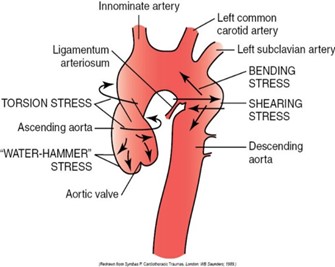Thoracic Aortic Injury (BTAI) Protocol - Blunt
exp date isn't null, but text field is
Blunt traumatic aortic injury (BTAI) is the second most common cause of death in trauma patients. 80% of BTAI patients will die before reaching a trauma center. For patients who survive to hospital, 50% will die within 24 hrs. This high mortality rate is related to the high incidence (40%) of severe associated injuries.
For patients with very suspicious CXR with hypertension OR BTAI diagnosis on helical chest CT or angiogram:
1. Start antihypertension regimen:
- Infuse esmolol bolus then maintenance rate for a goal BP (syst) 100-120 mmHg, HR < 100
- Add second agent such as Nitroprusside if BP (syst) still elevated despite esmolol
2. Treat ongoing life-threatening hemorrhage from other injuries prior to BTAI treatment (unless patient actively bleeding from aorta).
3. Treat pneumothorax and hemothorax in ED as you would for any trauma patient. For stable untreated hemothoraces beyond the emergent/resuscitation period check with Cardiac Surgery prior to drainage (patient may not need a chest tube if going to the OR soon for open repair).
4. Treat coagulopathy if present.
5. Once diagnosis of BTAI established consult Cardiac Surgery to determine early or delayed repair.
Reasons for delayed repair:
- Pa02/Fi02 ratio less than 150

- CNS injuries for which repair should be delayed:
- massive contusion
- evidence of shift on Head CT
- large areas of intracerebral blood
- high ICP (consistently >20)
- need for systemic heparinization for full bypass felt to be contraindicated by Neurosurgery.
- Ongoing major transfusion requirement or coagulopathy
- Massive, open, contaminated wounds or burn where likelihood of wound sepsis is high.
- Begin DVT prophylaxis at 24 hours if no other contraindication
6. Patients with BTAI who Cardiac Surgery is considering a stent-graft need a “Thoracic pre-endograft CT scan of the neck, chest, abdomen, and pelvis”. This should be performed 48-72 hrs post-injury once the patient is stable and resuscitation has ceased. Goal is to evaluate the aorta in a euvolemic (not hypovolemic) state to allow assessment of the circle of Willis/vertebral art for endograft technique.
7. If BTAI repair to be delayed for longer than 48 hours:
- Continue beta-blocker therapy, convert to long-acting agent (metoprolol or atenolol)
- Add secondary long-acting antihypertensives as necessary (clonidine, diuretic). Use diuretic if clinically safe and beyond resuscitative period to achieve euvolemia in fluid overloaded patients.
- BP (systolic) may be liberalized at 7 days to 150-160 mmHg
- Physical therapy may begin at day 5
8. Any concerns or problems should be discussed between ACS and CT surgery attendings. The following communication algorithm will be used for BTAI trauma patients requiring emergent operative intervention:
- Direct communication between Trauma Attending to Cardiothoracic CT Attending will take place immediately upon request for patient transfer/identification of BTAI in the ED
- Direct attending (ACS) to attending (CT Surgery) discussion will occur whenever emergent operative intervention is anticipated for BTAI.
- Pertinent images will be reviewed by the Trauma ACS attending physician and the Cardiothoracic Surgery attending physician to confirm optimal plan for patient care (operative vs. non-operative). If available, images via VPN will be reviewed for transfer patients.
- If plan is for emergent operative management a call, by the CT Surgery attending, will be made to the CVC-OR (232-4553) to request a hybrid OR. If not available, the next option will be the first available open CVC OR with a fluoroscopy table vs. Interventional Radiology Suite vs. OR at University Hospital.

